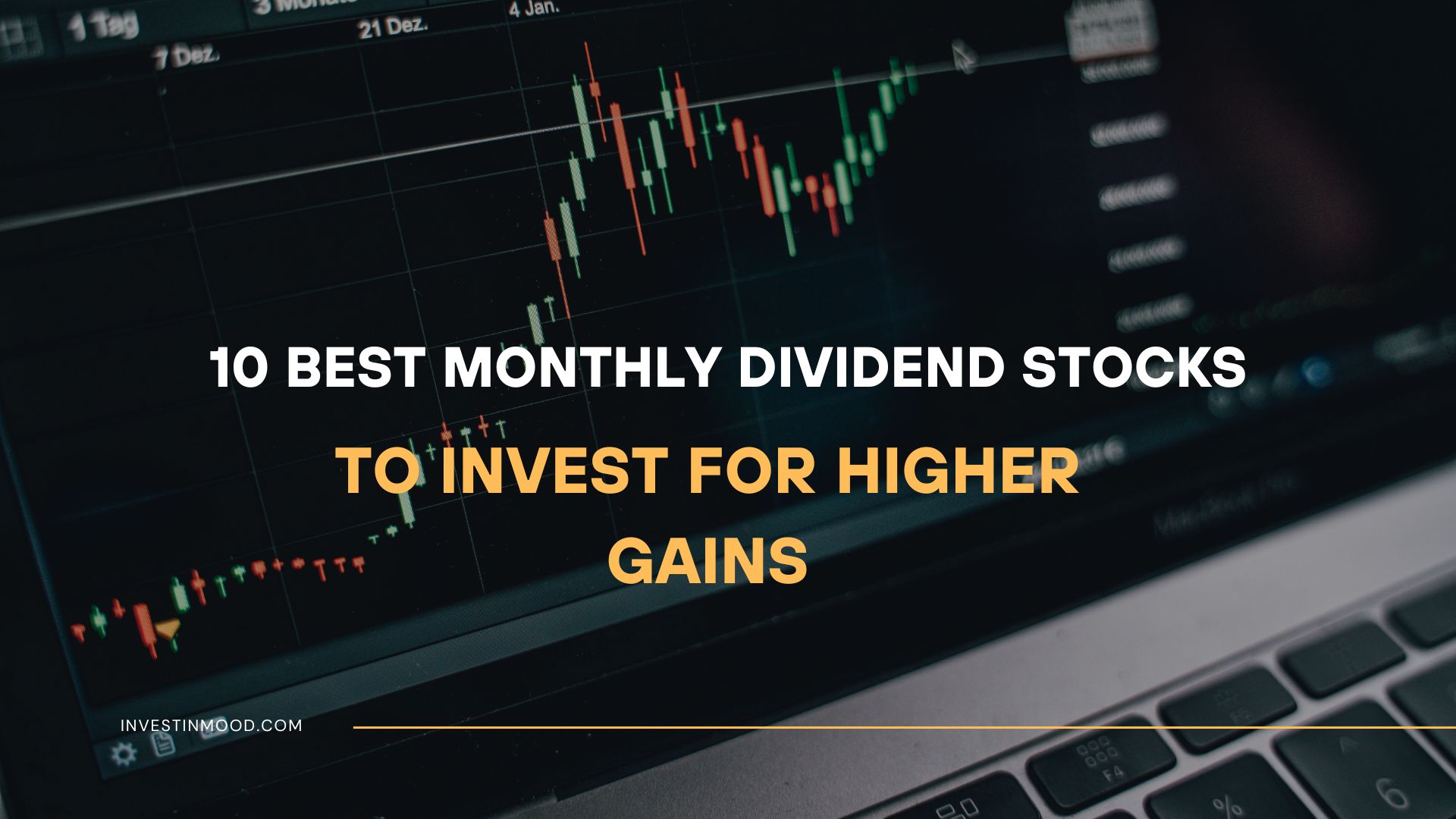
10 Best Monthly Dividend Stocks to Invest For Higher Gains
Taking control of your cash flow is a cornerstone of building lasting wealth. For investors seeking a steady, predictable income stream, monthly dividend stocks offer a compelling solution. This guide cuts through the noise to review the best monthly dividend payers available today. We help you find the perfect fit for your portfolio, whether you’re in the US, UK, or Canada, to generate passive income and achieve financial freedom.
What are Monthly Dividend Stocks
Monthly dividend stocks are publicly traded companies or funds that distribute a portion of their earnings to shareholders on a monthly basis, rather than the more common quarterly schedule. This consistent payout schedule can be highly attractive for retirees or any investor who relies on their portfolio for regular living expenses. Think of them as setting up a recurring paycheck from your investments, providing enhanced cash flow management and the benefit of more frequent compounding when dividends are reinvested.
Key Takeaways
Goal-Based Stock Selection
| Your Primary Goal | Best Stock Type | Key Metric to Look For |
|---|---|---|
| Steady Retirement Income | Established REITs & ETFs | High Dividend Coverage Ratio, Stable FFO |
| Aggressive Growth & Income | High-Yield BDCs | Net Investment Income (NII) Coverage, Portfolio Quality |
| Portfolio Diversification | Monthly Dividend ETFs | Low Expense Ratio, Broad Holdings Diversification |
| Inflation Hedging | Real Estate & Infrastructure REITs | Historical Dividend Growth, Contractual Rent Escalators |
For investors in the UK, remember that dividends from US stocks are subject to a 15% withholding tax, though this can often be reclaimed via a W-8BEN form. UK investors may also consider London-listed investment trusts that pay dividends monthly, such as certain offerings from JP Morgan or abrdn. US users have a wider selection and should ensure their broker supports DRIP (Dividend Reinvestment Plans) to automate compounding.
10 Best Monthly Dividend Stocks to Invest For Higher Gains
We’ve analyzed the market to bring you unbiased, detailed reviews of top-tier monthly dividend payers. Here are our top 10 picks for 2026, broken down by their strengths, ideal user, and key metrics.
1. Realty Income Corp. (O)
Overall Score: 4.7/5
Best For: Core holding for stable, predictable income.
Realty Income is a quintessential monthly dividend stock and a S&P 500 company structured as a Real Estate Investment Trust (REIT). Their business model focuses on acquiring and managing commercial, single-tenant properties under long-term, triple-net lease agreements. This means tenants are responsible for most property costs, providing Realty Income with highly predictable rental income. They have a remarkable track record of increasing their dividend for over 25 consecutive years.
Key Features:
- Monthly Dividends: The cornerstone of their appeal.
- Triple-Net Leases: Provides stable and predictable revenue.
- Diverse Tenant Base: Over 1,300 clients across 85 industries.
- Dividend Aristocrat Status: A long history of annual dividend increases.
- Exceptional Track Record Proven history of reliable and growing monthly dividends.
- High-Quality Portfolio Invests in essential, recession-resistant businesses.
- Strong Balance Sheet Investment-grade credit rating reduces financial risk.
- Lower Yield Often has a lower yield compared to riskier REITs.
- Interest Rate Sensitivity Share price can be volatile when interest rates rise.
- Limited Growth Potential Focus on stability can mean slower capital appreciation.
Why We Picked It: We chose Realty Income for the #1 spot because it is the gold standard for monthly dividend stocks. Its brand, “The Monthly Dividend Company®,” is well-earned through decades of consistent performance, making it a foundational holding for any income-focused portfolio.
2. AGNC Investment Corp. (AGNC)
Overall Score: 4.0/5
Best For: Investors seeking high current yield and who understand interest rate risks.
AGNC is a mortgage REIT (mREIT) that invests primarily in agency mortgage-backed securities (MBS). These are guaranteed by government-sponsored entities, which virtually eliminates credit risk. AGNC earns profit on the spread between the interest it earns on these MBS and the cost of borrowing to buy them. This model generates very high yields, which are passed on to shareholders monthly.
Key Features:
- High Monthly Yield: Consistently offers one of the highest dividend yields in the sector.
- Agency MBS Focus: Investments are backed by the U.S. government, minimizing default risk.
- Leveraged Model: Uses leverage to amplify returns, which also amplifies risk.
- Extremely High Yield Attractive for income seekers needing significant cash flow.
- Monthly Payouts Provides frequent compounding or income.
- Government-Backed Assets Underlying assets have minimal credit risk.
- High Interest Rate Risk Highly sensitive to Federal Reserve policy changes.
- Complex Business Model Can be difficult for novice investors to understand.
- Dividend Volatility The dividend amount is not fixed and can be cut.
Why We Picked It: AGNC earns a spot for its sheer yield-generating power. For experienced investors who can monitor the interest rate environment, it serves as a powerful tool for high monthly income, though it should be sized appropriately within a diversified portfolio.
3. Main Street Capital (MAIN)
Overall Score: 4.5/5
Best For: Total return seekers (income + growth).
Main Street Capital is a leading Business Development Company (BDC) that provides debt and equity capital to middle-market companies. Unlike many high-yield investments, MAIN has a strong track record of both paying stable monthly dividends and achieving significant capital appreciation. Their strategy involves a combination of yielding interest income from debt investments and participating in the equity upside of their portfolio companies, creating a powerful dual-stream of returns for shareholders.
Key Features:
- Monthly Dividends: Consistent monthly income from a diversified portfolio of private companies.
- Total Return Focus: Aims for both high current income and long-term capital gains.
- Internalized Management: Unlike many BDCs that use external advisors, MAIN manages itself, aligning costs with shareholder interests.
- Supplemental Dividends: Periodically pays special dividends on top of the regular monthly payout when performance is strong.
- Strong Track Record Excellent history of dividend payments and NAV growth.
- Attractive Total Return Potential for both high yield and share price appreciation.
- Shareholder-Friendly Structure Internalized management reduces fees and conflicts of interest.
- Economic Sensitivity Sensitive to economic recessions due to its lending focus.
- Complexity The underlying portfolio of private companies is less transparent.
- RIC Requirements Must distribute most income, limiting retained earnings.
Why We Picked It: MAIN earns a high spot for its exceptional ability to deliver both high monthly income and capital growth, a rare combination. Its disciplined approach and internalized management make it a best-in-class BDC.
4. STAG Industrial (STAG)
Overall Score: 4.2/5
Best For: E-commerce and industrial real estate exposure.
STAG Industrial is a REIT that focuses on the acquisition and operation of single-tenant industrial buildings across the United States. Their portfolio is heavily weighted towards warehouses and logistics centers, which are critical infrastructure in the age of e-commerce. By focusing on properties in secondary markets, they are able to acquire assets at more attractive prices, driving a solid yield which is paid out to shareholders monthly.
Key Features:
- Monthly Dividends: Reliable income from a critical asset class.
- E-Commerce Catalyst: Portfolio is directly leveraged to the growth of online retail and supply chain logistics.
- Geographic Diversification: Strategically invests in both primary and secondary markets to optimize risk and return.
- High Occupancy Rate: Consistently maintains high occupancy levels due to strong demand for industrial space.
- Sector Tailwinds Benefits from the long-term, structural growth of e-commerce.
- Diversified Tenant Base Not reliant on any single tenant or industry.
- Consistent Dividend Growth Has a history of steadily increasing its monthly payout.
- Interest Rate Sensitivity Vulnerable to rising interest rates which increase borrowing costs.
- Moderate Growth Focus on secondary markets can lead to more modest rent growth.
- Capital Intensive Requires significant capital to acquire and maintain properties.
Why We Picked It: We chose STAG for its pure-play exposure to the indispensable industrial real estate sector. It’s a modern income stock for a digital world, offering a monthly dividend backed by the warehouses that power the economy.
5. Pembina Pipeline Corp. (PBA)
Overall Score: 4.3/5
Best For: Energy infrastructure exposure with a stable, contract-based income.
Pembina Pipeline is a Canadian energy transportation and midstream service provider. The vast majority of its cash flows are generated from long-term, fee-based contracts, similar to a toll booth. This model provides remarkable stability and predictability, as it is not directly exposed to the volatility of commodity prices. Pembina converts this stable cash flow into a reliable monthly dividend for its shareholders.
Key Features:
- Monthly Dividends: Consistent income from critical energy infrastructure.
- Fee-Based Revenue: ~90% of EBITDA is from cost-of-service or take-or-pay contracts, insulating it from oil price swings.
- Integrated Assets: Owns pipelines, processing facilities, and storage, creating a cohesive and efficient network.
- Strong Investment-Grade Balance Sheet: Demonstrates financial health and reduces risk.
- Predictable Cash Flow The toll-model provides exceptional dividend safety.
- Essential Infrastructure Assets are crucial for North American energy production.
- Dividend Growth History Strong track record of increasing its distribution over time.
- Regulatory Risk Subject to government regulations and environmental policies.
- Limited Growth The mature asset base can limit high-growth prospects.
- Foreign Stock Dividends are subject to a 15% Canadian withholding tax for U.S. investors.
Why We Picked It: Pembina is a cornerstone energy income stock. It offers a safe, monthly dividend from a sector distinct from real estate, providing valuable diversification and a hedge against inflation for an income portfolio.
6. Apple Hospitality REIT (APLE)
Overall Score: 3.9/5
Best For: A pure-play, cyclical bet on the recovery and health of the travel industry.
Apple Hospitality REIT is a real estate investment trust that owns one of the largest portfolios of upscale, select-service hotels in the United States. Its properties are primarily branded under Marriott and Hilton flags, such as Courtyard, Residence Inn, and Hilton Garden Inn. This focus on branded, select-service hotels in strong markets allows it to capture demand from both business and leisure travelers. Its dividends are paid monthly, though the amount can be variable based on performance.
Key Features:
- Monthly Dividends: Variable payouts based on hotel performance (FFO).
- Premium Brands: Portfolio consists of well-recognized Marriott and Hilton hotels.
- Select-Service Model: Focuses on hotels without expensive amenities like large banquet halls, leading to higher profit margins.
- Geographic Diversification: Properties are located across many high-demand markets in the U.S.
- Leverage to Travel Directly benefits from strong economic activity and travel demand.
- High-Quality Portfolio Strong brand affiliations and modern properties.
- Dividend Growth Potential Dividends have significant potential to grow in a strong economy.
- High Cyclicality Performance is highly correlated with the health of the economy.
- Variable Dividend The monthly dividend is not fixed and was cut during the pandemic.
- Operating Complexity More operationally intensive than other types of REITs.
Why We Picked It: We included APLE as a tactical, higher-risk/higher-reward monthly payer. For investors bullish on the long-term resilience of travel, it offers a direct way to capture that trend with a monthly income stream.
7. Gladstone Commercial Corp. (GOOD)
Overall Score: 4.0/5
Best For: Investors seeking a diversified industrial and office REIT at an attractive yield.
Gladstone Commercial is a REIT that owns and operates a portfolio of net-lease industrial and office properties across the United States. Its strategy is to acquire properties essential to the operations of its tenants and lease them under long-term, triple-net leases. This provides a stable and predictable rental income stream, which funds its monthly distributions to shareholders. It often flies under the radar compared to larger peers, offering a compelling yield.
Key Features:
- Monthly Dividends: Steady monthly income from a diversified property base.
- Dual-Sector Focus: Balanced exposure to both industrial and office real estate.
- Triple-Net Leases: Tenants cover most costs, leading to predictable revenue.
- High Occupancy: Focuses on maintaining a high and stable occupancy rate.
- Attractive Current Yield Consistently offers a higher yield compared to many larger, more established REITs.
- Portfolio Diversification Invests across both industrial and office properties, helping reduce single-sector concentration risk.
- Stable Cash Flows The net-lease structure locks in predictable rental income over long contract periods.
- Office Sector Headwinds Exposure to office properties poses challenges amid remote and hybrid work trends.
- Higher Leverage Operates with a relatively elevated debt load, which may impact financial flexibility.
- External Management The REIT is externally managed, which can introduce fee structures and alignment concerns.
Why We Picked It: GOOD provides a solid, well-diversified monthly income stream at an attractive yield. It’s a strong option for investors looking beyond the most popular names without sacrificing the stability of the net-lease model.
8. EPR Properties (EPR)
Overall Score: 4.1/5
Best For: Experiential real estate exposure (theaters, ski resorts, eat & play).
EPR Properties is a unique REIT that specializes in owning properties related to experiences. Its portfolio includes megaplex movie theaters, eat & play entertainment centers, ski resorts, and other experiential destinations. This focus taps into the consumer trend of spending on experiences rather than just goods. EPR uses long-term, triple-net leases with experienced operators, creating a durable income stream to support its monthly dividend.
Key Features:
- Monthly Dividends: Income from the growing “experience economy.”
- Experiential Focus: Properties are focused on leisure and entertainment, a defensive niche.
- Triple-Net Leases: Provides predictable revenue from its tenants.
- Diversified Tenant Base: Includes operators like AMC, Topgolf, and Vail Resorts.
- Niche Market Leader A specialized REIT focused on experiential real estate, offering exposure to leisure and entertainment spending.
- Strong Post-Pandemic Recovery Performance has strengthened as consumers returned to theaters, attractions, and in-person activities.
- Attractive Dividend Yield Consistently provides a higher-than-average yield relative to many traditional REIT sectors.
- Tenant Concentration Risk A meaningful portion of revenue is tied to movie theater operators, which increases dependency on one industry.
- Cyclical Sensitivity Experiential real estate is closely linked to discretionary spending, making it vulnerable during economic slowdowns.
- Pandemic Exposure The business model is highly sensitive to disruptions such as lockdowns or mandated closures of entertainment venues.
Why We Picked It: EPR offers a compelling and differentiated thesis. It’s a bet on the enduring human desire for shared experiences, packaged in a monthly-paying REIT, making it a fascinating addition for portfolio diversification.
9. LTC Properties (LTC)
Overall Score: 4.0/5
Best For: Defensive exposure to the aging population demographic through healthcare real estate.
LTC Properties is a REIT that invests in a portfolio of senior housing and healthcare properties through mortgage loans, property lease agreements, and other investments. Its portfolio includes skilled nursing centers, assisted living facilities, and memory care communities. This provides a defensive, needs-based exposure to the powerful long-term demographic trend of an aging population. The company funds its monthly dividend from the rent and interest payments it receives from operators.
Key Features:
- Monthly Dividends: Income from the essential and growing healthcare sector.
- Senior Housing Focus: Direct exposure to the favorable aging population demographic.
- Dual Investment Strategy: Invests through both equity (properties) and debt (mortgages) for flexibility and risk management.
- Experienced Management: Team has deep expertise in the healthcare real estate sector.
- Defensive Sector Operates in healthcare, a non-discretionary and essential service category that remains resilient across cycles.
- Demographic Tailwinds An aging U.S. population continues to drive growing demand for senior housing and skilled nursing facilities.
- Stable Operator Relationships Maintains long-term partnerships with experienced operators, supporting steady occupancy and cash flow stability.
- Operator Risk Rental income depends heavily on the financial health and performance of its tenant and borrower network.
- Regulatory Complexity Exposure to a highly regulated industry where changes in government reimbursement policies can impact profitability.
- Labor Cost Pressures Healthcare operators face rising staffing and wage costs, which can strain their margins and rent-paying capacity.
Why We Picked It: LTC offers a defensive, demographic-driven monthly income stream. It’s a way to invest in the essential healthcare sector through the stability of real estate, making it a valuable ballast in an income portfolio.
10. Shaw Communications (SJR)
Overall Score: 3.8/5
Best For: Investors seeking a high-quality, low-volatility telecom stock with monthly dividends.
BCE Inc. (BCE) is one of Canada’s largest telecommunications and media companies, providing wireless, wireline, and media services to millions of customers. As a “blue-chip” utility-like stock, it generates massive, predictable cash flows from essential communication services. This financial stability allows it to pay a generous and reliable dividend to shareholders on a monthly basis, making it a cornerstone holding for Canadian income investors and those seeking international exposure.
Key Features:
- Monthly Dividends: Reliable income from a telecom giant.
- Oligopoly Market: Operates in a stable Canadian market with limited competition.
- Essential Services: Provides must-have wireless and internet services.
- Strong Cash Flow Generation: Consistently produces the cash needed to support its dividend.
- Reliable Payout A Dividend Aristocrat with a long, unbroken history of dividend payments.
- Defensive Business Operates in communication services, a non-discretionary and recession-resistant sector.
- Strong Market Position A leading provider in a stable and heavily regulated industry, supporting consistent performance.
- Slow Growth Mature business model with limited potential for rapid expansion.
- High Debt Levels Significant debt is required to fund ongoing infrastructure investments.
- Foreign Stock Considerations Dividends are subject to a 15% Canadian withholding tax for U.S. investors.
Why We Picked It: We close the list with BCE to represent a classic, low-volatility, blue-chip monthly dividend payer from outside the REIT and BDC space. It offers safety, reliability, and exposure to the essential telecommunications sector.
Real-World Example: Building a Monthly Income Stream
Consider Maria, a retiree with a $200,000 portfolio focused on quarterly dividends. She received $1,500 every three months, which made budgeting for her monthly $500 grocery bill slightly awkward, sometimes requiring her to dip into savings. By strategically allocating a portion of her portfolio to a mix of monthly dividend stocks like Realty Income (O), AGNC (AGNC), and a monthly dividend ETF (RYLD), she engineered a consistent ~$500 monthly income. This predictable cash flow now covers her grocery bill perfectly, and she automatically reinvests any surplus, allowing her capital to compound more frequently. The psychological benefit of seeing a deposit hit her account every month has also provided immense peace of mind.
How to Analyze a Monthly Dividend Stock
Before you invest, it’s crucial to look beyond the yield. Here’s a step-by-step guide to analyzing any monthly dividend stock.
- Check the Payout Ratio: For traditional corporations, this is Dividends / Earnings Per Share. For REITs, look at Dividends / Funds From Operations (FFO). A ratio over 100% is a red flag, indicating the dividend may not be sustainable. Aim for a ratio below 90% for safety.
- Assess the Business Model: Do you understand how the company makes money? Is it a stable, recession-resistant business (like Realty Income) or a cyclical, economically sensitive one (like Apple Hospitality)?
- Review the Balance Sheet: Check the company’s debt levels. A high debt-to-equity ratio can be dangerous in a rising interest rate environment. Look for companies with investment-grade credit ratings.
- Examine Dividend History: Has the company consistently paid and ideally grown its dividend over time? A long track record is a good sign of management’s commitment to shareholders.
- Understand the Sector Risks: Know the specific risks. REITs are sensitive to interest rates. BDCs are sensitive to economic health and default rates. mREITs are hyper-sensitive to interest rate spreads.
Conclusion
Ultimately, incorporating monthly dividend stocks into a diversified portfolio can be a strategic move for enhancing cash flow and harnessing the power of frequent compounding. While the allure of a high yield is strong, the key to long-term success lies in prioritizing sustainability and understanding the underlying business. The right monthly dividend stocks act as pillars of an income-generating empire, providing the steady capital needed to fund your lifestyle and reinvest for future growth. Start by building a core position in a proven performer and gradually diversify into other opportunities as your knowledge and confidence grow.
How Monthly Dividend Stocks Relate to Other Concepts
| Feature | Monthly Dividend Stocks | Quarterly Dividend Stocks | Growth Stocks |
|---|---|---|---|
| Primary Function | Regular Income & Compounding | Income & Long-Term Holding | Capital Appreciation |
| Payout Frequency | Monthly | Quarterly (Typically) | Rarely or Never |
| Ideal For | Retirees, Income-Focused Investors | Long-Term Buy-and-Hold Investors | Investors with Long Time Horizons |
| Sector Examples | REITs, BDCs, mREITs | Blue Chips (JNJ, PG), Utilities | Tech (AAPL, MSFT), Biotech |
Related Terms
- Dividend Yield: The annual dividend payment divided by the stock’s price, expressed as a percentage. It’s a measure of the income generated relative to the investment.
- Dividend Aristocrat: A company in the S&P 500 that has increased its dividend for at least 25 consecutive years. Realty Income (O) is an example.
- REIT (Real Estate Investment Trust): A company that owns, operates, or finances income-generating real estate. They are required to distribute at least 90% of taxable income to shareholders.
- DRIP (Dividend Reinvestment Plan): A program that allows investors to automatically reinvest their cash dividends into additional shares of the underlying stock, often without commission fees.
Frequently Asked Questions
Recommended Resources
- Understanding REITs: A Beginner’s Guide
- How to Build a Diversified Dividend Portfolio
- BDCs: High Yield with High Risk?
- For detailed company data and SEC filings, visit the U.S. Securities and Exchange Commission’s EDGAR database.
- To understand dividend safety metrics, Simply Safe Dividends is an excellent resource.
- For a deep dive into REIT analysis, the Nareit website is the industry’s leading source.





